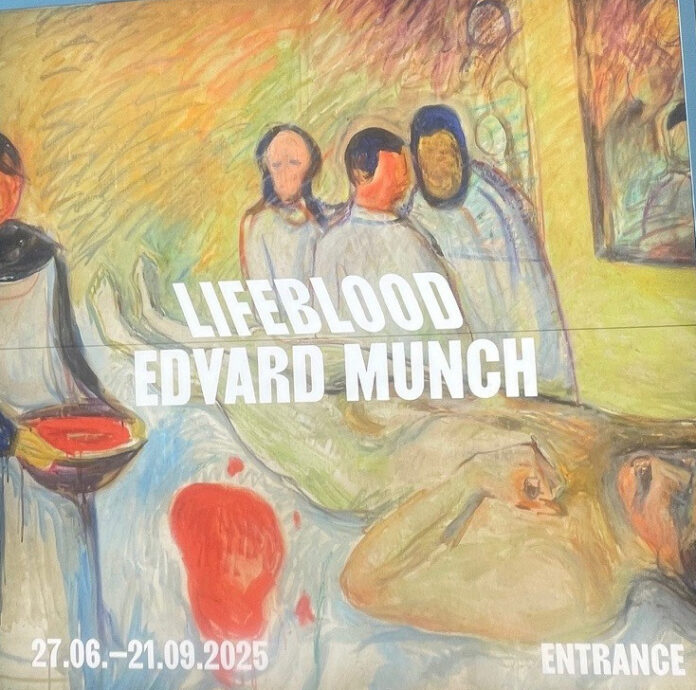“Lifeblood” is a profound and thought-provoking exhibition that connects Edvard Munch’s artistic universe to the evolution of medical practice, inviting the public to reflect on the body, care, and health from both historical and personal perspectives. This is a unique Munch exhibition that focuses on health and medical advances.
The exhibition at the Munch Museum in Oslo offers a unique perspective by placing Munch’s art—featuring themes such as illness, death, and vulnerability—in direct dialogue with historical medical objects, including respirators and other medical equipment. The illnesses experienced by Munch and his family are central themes in the paintings selected for this context. His mother died of tuberculosis at the age of 31 when Munch was a child. He himself suffered from various illnesses throughout his life, including the Spanish flu in 1919.

“Illness followed me throughout my childhood and youth – the tuberculosis bacillus planted its blood-red flag so victoriously on the white handkerchief… One Christmas Eve, I lie there, 13 years old – and the blood pours from my mouth – the fever raged in my veins – fear screamed within me.”

The quote above appears in the Lifeblood catalogue, published in connection with the exhibition. It features contributions from 27 writers from various disciplines, offering insights into Munch’s relationship with the body and illness, and showing how profoundly he was affected by sickness from an early age.

Munch considered his illnesses as pets—he nurtured all his ailments like cherished creatures, explains curator Allison Morehead during the exhibition’s press preview in July 2025.
*************************************
Related: A Travel Guide to All the Places Edvard Munch Lived and Loved
*************************************

For the first time, the public gains insight into Edvard Munch’s life, including his struggles with illness and his encounters with the modern medical system. His artworks are placed in direct conversation with historical medical objects such as infant incubators and vaccination certificates. This connection aims to shed light on our modern experiences of health, disease, birth, death, and care. Munch’s art is powerful and visceral—it conveys the vulnerability of the human body and the healing promise of medicine.
When Edvard Munch was born in 1863, few people in Norway—or elsewhere—were born or died in hospitals. By the time he died in 1944, births and deaths in hospitals had become standard practice in many parts of the world.

Visitors are invited to reflect on their own experiences of illness, disability, and health. The exhibition features items on loan from various institutions, including the Norwegian Museum of Science and Technology (Oslo), the Welcome Collection (London), the Deutsches Hygiene-Museum (Dresden), the Musée des Moulages (Paris), and others.
“Lifeblood” is a remarkable exhibition that merges medical history with Munch’s art. It deeply touches viewers by highlighting vulnerability, human care, and medical progress through an artistic lens.
Facts:
Lifeblood opened on June 27, 2025, and ran through September 21, 2025. The exhibition included 150 works by Munch and 150 historical medical objects loaned from collections in Norway, Denmark, France, Germany, and the UK.
Works from the MUNCH collection depict hospitals, asylums, sanatoriums, doctors, patients, and nurses. Among the featured works are the original version of The Sick Child (1885–1886), Munch’s monumental Self-Portrait with the Spanish Flu (1919), and his atmospheric Night in Saint-Cloud (1890).
The exhibition “Lifeblood – Edvard Munch“ (English title: Lifeblood) is curated by Allison Morehead, professor of art history and cultural studies at Queen’s University in Kingston, Canada, who also leads the exhibition’s research theme. She initiated the exhibition with a focus on Munch’s health and medical developments. Art historian Signe Marie Endresen, who earned her PhD from the University of Oslo in 2015, collaborated with Morehead through MUNCH to bring the exhibition to life.
A catalogue titled “Lifeblood,” published in connection with the exhibition, is a hardcover book in Norwegian, edited by Heidi Bale Amundsen, and published by MUNCH Publishing. Released on July 10, 2025, it includes texts by curator Allison Morehead and a wide range of contributors—27 in total—including art and medical historians, healthcare professionals, activists, artists, and authors—who reflect on the themes of the body, health, and care through Munch’s artworks and related medical objects.

Unique Munch Exhibition – Focus on Health and Medical Advances, written exclusively for Daily Scandinavian by Anne Marit Muri. Muri is a former editor of, among others, Magasinet Kunst, and has written reports on art and culture for several years.
She is the author and initiator of the book Kunstnerliv, Portraits of 19 Contemporary Artists, which was published in 2018 and voted the year’s most beautiful art book in 2019 by Grafill. She is also the author of the book, Det gåtefulle lyset, Svalbard, which was published in autumn 2022 by the publisher Utenfor Allfarvei in Harstad.
Muri is educated at the University of Oslo and the University of Bergen. She is currently pursuing a master’s degree in media development at Oslo Met, in addition to developing new book projects, and is a writer for several magazines. She is a regular contributor to Daily Scandinavian, writing about fine arts, culture, and lifestyle.
Editor’s remarks: Unfortunately, this article has been published after its closing date due to technical problems.


